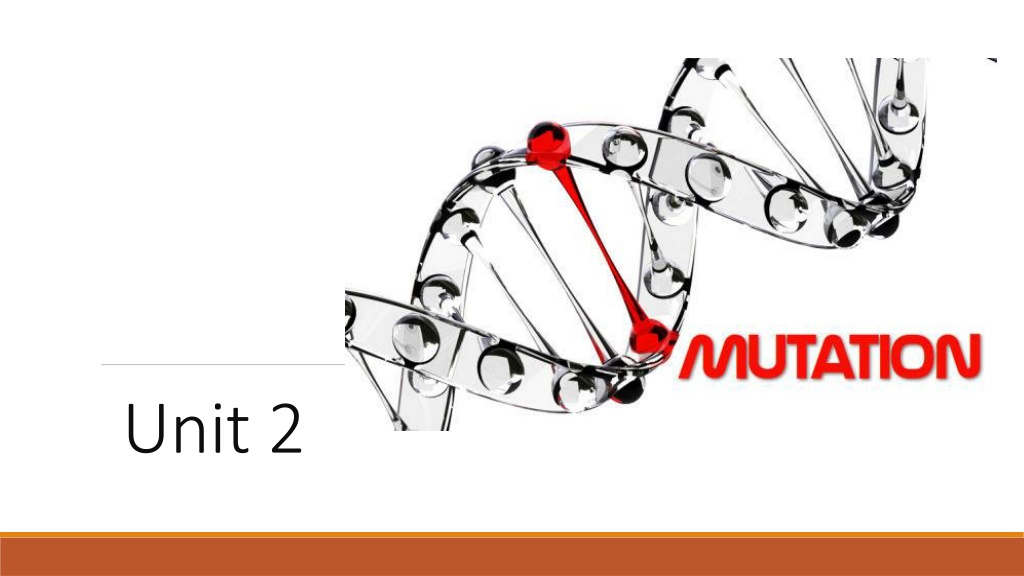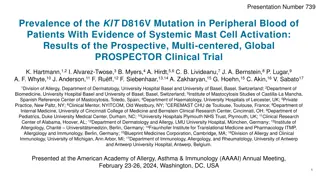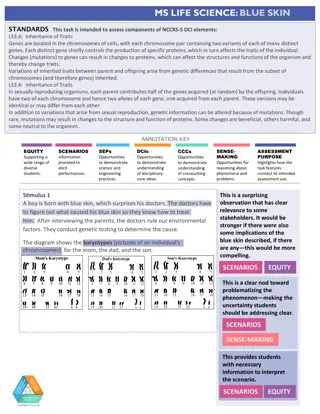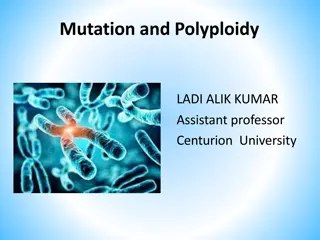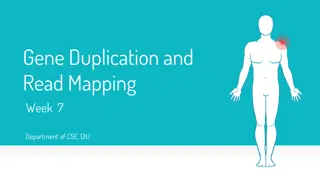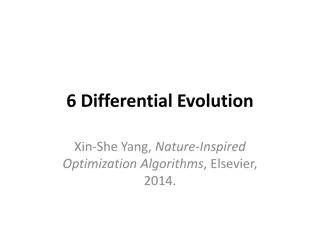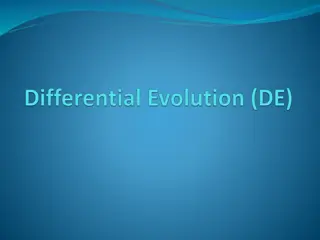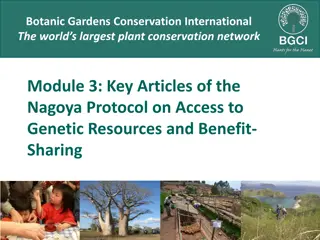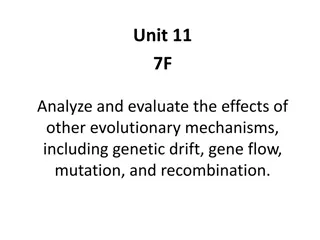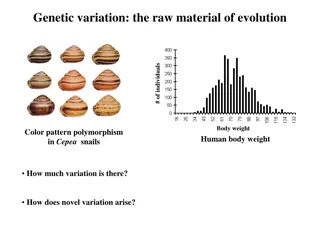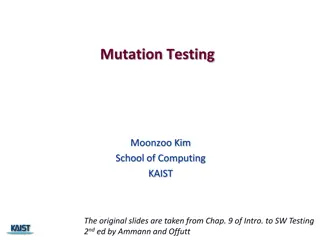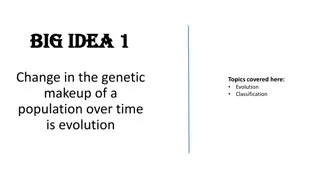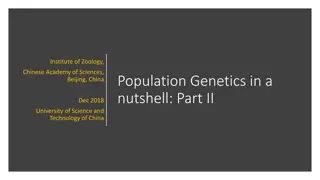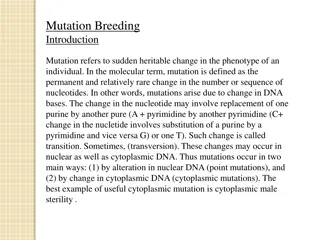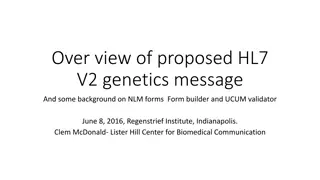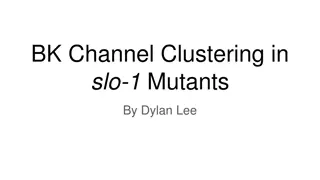Understanding Genetic Mutation and Its Impact on Evolution
Genetic mutations are a natural process that introduces variations in DNA sequences, creating new alleles and genetic diversity within populations. These mutations can have both positive and negative effects on individuals, influencing survival and reproduction. By examining different types of mutations like base substitution and frameshift, we can understand how genetic variations contribute to the evolutionary process through natural selection.
Download Presentation

Please find below an Image/Link to download the presentation.
The content on the website is provided AS IS for your information and personal use only. It may not be sold, licensed, or shared on other websites without obtaining consent from the author. Download presentation by click this link. If you encounter any issues during the download, it is possible that the publisher has removed the file from their server.
E N D
Presentation Transcript
What is Mutation? Is a natural process that changes a DNA sequence. As a cell copies its DNA before dividing, a typo occurs every 100,000 or so nucleotides. That s about 120,000 typos each time one of our cells divides. Mutant or Mutation to describe something undesirable or broken. Rarely cause death or disease Generates new variations that can give an individual a survival advantage. Most often, mutation gives rise to variations that are neither good nor bad, just different.
Mutation Generates New Alleles The whole family is one species with the same genes. Mutation creates slightly different versions of the same genes, called alleles. These small differences in DNA sequence make every individual unique. They account for the variation we see in human hair color, skin color, height, shape, behavior, and susceptibility to disease. Individuals in other species vary too, in both physical appearance and behavior.
What is the advantage of genetic variations? 1.It helps populations change over time. 2.Variations that help an organism survive and reproduce are passed on to the next generation. 3.Variations that hinder survival and reproduction are eliminated from the population. 4.This process of natural selection can lead to significant changes in the appearance, behavior, or physiology of individuals in a population, in just a few generations.
Types of Mutation Types of Mutation 1. Base Substitution 2. Insertion and deletion 3. Frameshift
1. Base Substitution a.The simplest type of gene-level mutation b.Swapping of one nucleotide for another during DNA Replication. c.Example: during replication, a thymine nucleotide might be inserted in place of a guanine nucleotide. d.Only single nucleotide with a gene sequence is changed so only one codon is affected
Only a single codon in the gene sequence is changed in base substitution mutation.
Sub-categories of mutations in base substitution 1. Missense Mutations - The altered codon leads to insertion of an incorrect amino acid into a protein molecule during translation. Illustration:
Sub-categories of mutations in base substitution 2. Nonsense Mutations - altered codon prematurely terminates synthesis of a protein molecule. Illustration:
Sub-categories of mutations in base substitution 3. Silent Mutations - altered codon codes for the same amino acids as the unaltered codon. Illustration:
2. Insertion and Deletion Are two other types of mutations that can affect cells at the gene level. 2.1. Insertion Mutation Occurs when an extra nucleotide is added to the DNA strand during replication. This can happened when the replicating strand slips or wrinkles, which allows the extra nucleotide to be incorporated
During an insertion mutation, the replicating strand [ slips ] or forms a wrinkle, which causes the extra nucleotide to be incorporated.
2.2. Deletion Mutation subsequently causes a nucleotide to be omitted from the replicated strand. (see illustration below) - occurs when a wrinkle forms on the DNA template strand and
In deletion mutation, a wrinkle forms on the DNA template strand, which causes a nucleotide to be omitted from the replicated strand.
Frameshift Mutation Is the type of mutation which is caused during insertion and deletion of one or more nucleotides during replication. The outcome of a frameshift mutation is complete alteration of the amino acid sequence of a protein. occurs during translation because ribosomes read the mRNA strand in terms of codons, or groups of three nucleotides.
cont. Frameshift Mutation These groups are called the reading frame. Thus, if the number of bases removed from or inserted into a segment of DNA is not a multiple of three (Figure 4a), the reading frame transcribed to the mRNA will be completely changed (Figure 4b). (see next slide) Consequently, once it encounters the mutation, the ribosome will read the mRNA sequence differently, which can result in the production of an entirely different sequence of amino acids in the growing polypeptide chain.
Figure 4a. If the number of bases removed or inserted from a segment of DNA is not a multiple of Figure 4a. If the number of bases removed or inserted from a segment of DNA is not a multiple of three three Figure 4b. a different sequence with a different set of reading frames is transcribed to mRNA Figure 4b. a different sequence with a different set of reading frames is transcribed to mRNA
Lets have a game: Pass the message!!!! Mechanics: - 5 students representatives for this game - the teacher will give instruction to 5 students regarding the game - Message will be open only by the teacher - the rest of the students will observe Click and Move me to reveal the message the quick brown fox jumped over the lazy dog
To understand better THE BIG BAD FLY HAD ONE RED EYE AND ONE BLU EYE . Now, suppose that a mutation eliminates the sixth nucleotide, in this case the letter "G". This deletion means that the letters shift, and the rest of the sentence contains entirely new "words":
New message after deletion of G codon: THE BIB ADF LYH ADO NER EDE YEA NDO NEB LUE YE . This error changes the relationship of all nucleotides to each codon, and effectively changes every single codon in the sequence. Consequently, there is a widespread change in the amino acid sequence of the protein. Lets consider an example with an RNA sequence that codes for a sequence of amino acids:
Normal codon: AUG AAA CUU CGC AGG AUG AUG AUG With the triplet code, the sequence shown in the figure below corresponds to a protein made of the following amino acids: Methionine-Lysine-Leucine-Arginine-Arginine-Methionine-Methionine-Methionin
Now.. suppose that a mutation occurs during replication, and it results in deletion of the fourth nucleotide in the sequence. When separated into triplet codons, the nucleotide sequence would now read as follows (Figure 6): (see next slide)
AUG AAC UUC GCA GGA UGA UGA UG This series of codons would encode the following sequence of amino acids: Methionine-Asparagine-Phenylalanine-Alanine-Glycine-STOP-STOP Figure 6
Conclusion Each of the stop codons tells the ribosome to terminate protein synthesis at that point. Consequently, the mutant protein is entirely different due to the deletion of the fourth nucleotide, and it is also shorter due to the appearance of a premature stop codon. This mutant protein will be unable to perform its necessary function in the cell.
What causes mutation? Mutagens external agents of genetic change Chemicals, ultraviolet radiation, viral Causes alterations in the molecular structure of nucleotides, ultimately causing substitutions, insertions, and deletions in the DNA sequence.
What are the consequences of mutations? Genetic diversity in populations Beneficial to an organism by making it better able to adapt to environmental factors. Harmful in some instance; like increased susceptibility to illness or disease Neutral proving neither beneficial nor detrimental outcomes to an organisms
Brain teaser activity!!! Brain teaser activity!!! 1. What factors that causes mutation? 2. What type of mutation that causes entire shifts of RNA sequence? 3. Is insertion and deletion results frameshifting? 4. what will happen if mutation occurs in a gene?
